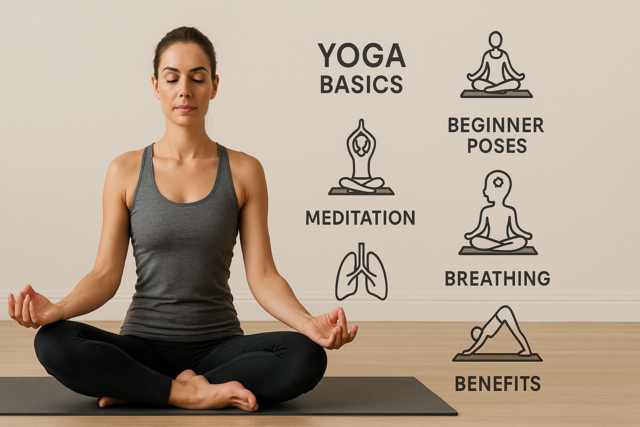Your body and mind must be alert, and you must feel relaxed and comfortable, during meditation. But, you should not be so relaxed that you run the risk of falling asleep. As your body and mind relate to one another, it is vital to keep your body alert as well – by maintaining proper meditation postures.
When most people think of someone meditating, they envision someone sitting in the lotus position – or sitting cross-legged on the floor. For many Westerners and for many people in general, this is a difficult position to maintain for an extended period of time. Will this position be very uncomfortable for you? If so, it will be very difficult or perhaps impossible for you to concentrate on meditating.
If you maintain a posture that is uncomfortable for you, you will soon begin to feel frustrated. You will begin to feel that perhaps you do not "have what it takes" to engage in effective meditation. Nothing could be farther from the truth. You need not conform to any expectation. It is important for you to discover a posture that is right for you. Keep in mind that it is important for you to feel alert, relaxed, and comfortable.
Although most meditation postures are safe for most people, you should check with your family physician or a medical professional before starting any physical routines.
We shall examine some important elements to meditation postures. These elements are important regardless of the specific posture you choose to use.
This is the optimum position for effective meditation. Keep your back, neck, and head in a straight line. This position will help you feel confident, strong, and alert. These are all emotions that you want to feel during your meditation practice.
Unless you are engaging in yoga during your meditation remain perfectly still during your practice, but not rigid. Practice your mindfulness of breathing exercises and feel your body and mind relaxing, entering into a state of calmness and tranquility.
Shoulders relaxed
Are your shoulders relaxed as you read this? Many people do not realize it, but we contract our shoulders for a significant portion of the time. Relax your shoulders, and feel the difference. During your meditation practice, be sure to keep your shoulders completely at rest.
During your practice, keep your head straight up over your spine, and do not lean to one side. Practitioners often describe this position as if you had a string attached to the center of your head and it was holding your head up straight.
Keep your eyes relaxed. You may close them if you wish, or gently fix your gaze upon an object in front of you. Remember to keep your head perfectly straight. Keeping your eyes closed will make you more prone to falling asleep, but with your eyes closed you will also be less distracted by your environment.
Keep your face completely relaxed. Meditation is about removing all your masks. You need not make any expression at all during your practice. Be as relaxed and free as possible.
We will explore three typical meditation postures, and you may experiment with all three of them to find the one that is most comfortable for you.
The "easy posture" is ideal for meditation, but only if you have the right amount of flexibility. This position is not for everyone, despite its name. You may sit on a cushion if this position is uncomfortable for you.
a. Sit on the floor and keep your legs straight out in front of you.
b. Cross your legs at your ankles. Make sure your left leg is on top of your right leg.
c. Slide your feet toward you, until the right foot is under the left knee and the left foot is under the right knee.
You may alternate how you cross your legs during subsequent practices.
If you find that sitting on the floor is not comfortable for you, you may find that it is more appropriate for you to sit in a chair.
a. Use a sturdy chair and sit near the front edge of the seat. Be sure not to lean against the back of the chair. The sitting position may cause some to fall asleep in deep meditation, so you want to remain alert by not leaning against the back.
b. Keep your feet flat on the floor.
c. Keep your back as straight as possible.
d. Rest your hands on your knees, with your palms facing downward.
This pose is a variation of the sitting posture, and some people might find it more comfortable. Some people with back discomfort might find this to be an appropriate posture for meditation.
a. Kneel on the floor.
b. Sit back on your heels.
c. Keep your knees and legs as close together as possible.
d. Place the palms of your hands on top of your thighs.
Many people believe this is the ideal position for meditation, but it is not for everyone. All postures, if done safely and correctly, can result in effective meditation.
a. Stretch your leg and knees.
b. Sit on the floor, or you may use a cushion.
c. Place your lower left leg on your upper right thigh. This is also called the Half Lotus.
d. Place your lower right leg on your upper left thigh.
You may reverse steps c and d by using the opposite leg, if the opposite cross-legged position is more comfortable for you.
While it is normal to experience some discomfort during certain postures, you must listen to your body and know its limits. It is acceptable for a leg to fall asleep during a sitting posture. Gently rub your leg and stretch it. If you can do the traditional postures described above, then you should continue doing so. If you find them too uncomfortable, use the chair posture or find a posture that is right for you. Meditation, of course, is not about pain or being uncomfortable. Over time, you will find your body adapting to the postures you use and you will find meditation to be extremely relaxing and calming.
Meditation was born in the Eastern culture. It was originally derived from Hinduism during the Vedic period, which extended from approximately 2,000 BCE to 600 BCE. Meditation was initially used by the Hindus as a way of discerning the true nature of God, or Brahman.
In approximately 500 BCE, the Buddha, Siddhartha Gautama, taught meditation to his many followers, and in doing so showed how meditation can assist in the Path to Enlightenment. The Buddha founded Buddhism, and it is generally believed by many that the major rift between Buddhism and Hinduism occurred when their respective followers used meditation in different ways.
While the Hindus believed that meditation can lead to the true discernment of God, Buddhists believed, and still do believe, that meditation leads to a greater self-awareness, and to the realization that all things are interconnected.
Buddha taught many disciples and his teachings quickly spread throughout the Asian continent. As each protégé mastered the art of meditation, new techniques and new interpretations were discovered. When Buddhism reached China and Tibet, practitioners in each area added their own unique techniques.
Siddhartha Gautama is generally recognized as the "Supreme Buddha" by Buddhists. Although the date of this birth is uncertain, it is generally accepted by most historians that he lived from 563 BCE to 483 BCE.
Different branches of Buddhism regard the nature of the Supreme Buddha differently. In one camp there are the Theravada Buddhists who believe in the Buddha's humanity – a human with immense skill and wisdom. The Mahayana Buddhists, however, view the Buddha as a transcendent being, who is immortal and present in all things.
Buddhist texts reveal that the Buddha spent four months out of the year spending time with his monks and teaching them the way to enlightenment. Upon his death, his monks carried on this tradition. Councils were set up many years after his death so that monks could review his teachings. They categorized his many teachings into distinct canons of work.
Siddhartha was born into vast wealth, and it is believed that he commissioned three immense palaces for his personal use. His father, a king of the Shakya people of ancient India, instilled in him at an early age a desire to be king. The king discouraged his son from any activity that did not directly aid his quest in becoming king, including the practice of any religious or humanitarian endeavors.
Although he was provided with all the trappings of wealth and power, Siddhartha believed there was more to life than money and power. At the age of 29, he was a prince his entire life and shielded from every conceivable ill in society. His father even shielded him from age – Siddhartha was overcome with emotion upon seeing an old, decrepit man. Thus he began the life of an ascetic, which is characterized as a life of abstinence.
Buddhist texts reveal that he sat under a tree, the Bodhi tree in Bihar, India, and vowed never to arise until he had discovered the truth of all things. After 49 days of meditating, or practicing anapanasari – mindfulness of breathing – he attained enlightenment.
He realized during this meditation that the cause of all human suffering was ignorance. He believed that all human beings were capable of achieving Nirvana, or the freedom from death and suffering. He categorized his beliefs into the Four Noble Truths: the Truth of Suffering, the Truth of the Cause of Suffering, the Truth of the Cessation of Suffering, and the Truth of the Path to the Cessation of Suffering.
While the origins of meditation are found in Hinduism and Buddhism, many other religions adopt similar practices. Christianity is over two thousand years old and it has several rituals and practices that are similar to Eastern meditation. Christian rituals such as prayer, the sacraments, penance, and labyrinth walking are all forms of meditation.
The Eastern Orthodox Christian Church has practiced hesychasm for centuries. Hesychasm is the process of deep introspection. One looks inward to discern the true nature of God. In Hesychasm, a person repeatedly prays the Jesus Prayer – "Lord Jesus Christ, son of God, have mercy on me, a sinner."
Thousands of years after it was so firmly rooted in Eastern culture, Meditation spread to Western society. Whereas most Westerners are not apt to spend 49 days mediating under a tree, its widespread popularity in the United States and other countries is due to its many healthful benefits. In the 1960s and 1970s, many college professors and many people in the scientific research community began to put meditation to rigorous tests. Many scientific studies have confirmed the beliefs that people have held for millennia. While meditation might not lead to enlightenment for everyone, it will certainly bring harmony to your life.





























